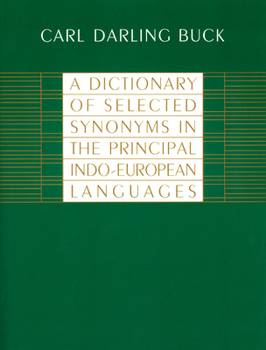A Dictionary of Selected Synonyms in the Principal Indo-European Languages
Originally published in 1949 and appearing now for the first time in a paperbound edition, Buck's Dictionary remains an indispensable tool for diachronic analysis of the Indo-European languages.... This description may be from another edition of this product.
Format:Paperback
Language:English
ISBN:0226079376
ISBN13:9780226079370
Release Date:June 1988
Publisher:University of Chicago Press
Length:416 Pages
Weight:2.35 lbs.
Dimensions:0.9" x 8.5" x 11.0"
Customer Reviews
5 ratings
Flawed, Dated Masterpiece
Published by Thriftbooks.com User , 20 years ago
I wouldn't dream of dissuading anyone with an interest in IE lingustics from buying a copy of this fascinating tome, but at the same time would point out that it has some glaring errors, mainly due to its age:I see another reader complaining about underrepresentation of non-European IE languages. He's not bad on Sanskrit, but point taken on Iranian (which he seems to regard as a minor dialect of Sanskrit). Hittite and Tocharian, Albanian and Armenian are underrepresented too. At the same time, some Western languages are underrepresented, such as Portuguese and Catalan. Maybe not a problem where forms are cognate with Spanish/French/Italian, but it is when they aren't.My main problem with Buck, however, is that he by and large ignores connections with other language families, assuming that everything can be explained within IE. This sometimes pushes him into absurd assertions - he can't find an Old Irish word for dancing, so he claims that there was no dancing in Ancient Ireland. Granted, this work was written at the end of the 1940s, before the work on long-distance comparisons of Brunner, Ilyich-Svitych, Greenberg, Bomhard et al. Not a defect in itself, but his etymologies can no longer be taken at face value.
A valuable addition to my library
Published by Thriftbooks.com User , 22 years ago
I have been able to have only a cursory glance, so far, but the remarkable contents of this book have enabled me to confirm a theory on which I am working, relating to the palaeopyschology of links between natural phenomena and the emergence of belief in divinities. I look forward to having a much more detailed browse. The size of the font in this reduced facsimile is indeed small. I have poor eyesight, with thick multifocal lenses in my spectacles, but have little trouble reading the book.Since writing the above, I've used the book often in searches for IE cognates, particularly Sanksrit, and have found it very useful.Brian Barratt...
The Ultimate Bathroom Book!
Published by Thriftbooks.com User , 22 years ago
You can pick this book up and flip to any page at random and learn something that will make you go "huh!". I recommend this book for anybody at all interested in language or thought, either just getting into linguistics or a tenured professor.The entries are from basic vocabulary, grouped by topic (food, familial relations, etc.), though there's an alphabetical index in the back. For each entry, Mr. Buck gives the word (sometimes a couple different words) in Ancient Greek, Modern Greek, Latin, the Romance languages, the Celtic languages, the main Germanic languages (incl. Old, Middle, and Modern English), Balto-Slavic, and usually Indo-Iranian (occasionally Armenian). But the cool thing is that then he gives an always-enlightening discussion below on how they are related, what ideas lie behind different word-choices, how they've changed, and so forth. This discussion is usu. about 2-3 times the length of the list and is the best part.This book used to be a big hefty lieberry book, but the University of Chicago has reprinted it into a handy paperback, with four of the old pages on each new one. One reviewer said you'd need a magnifying glass, but I have terrible vision and I can read it just fine.It's a great book to read on the toilet, or whenever you're just sittin' around waitin' for somethin' to happen. You'll learn something every time you read it, and at this price it's one of the best book-deals you'll get anywhere.
Classic dictionary
Published by Thriftbooks.com User , 24 years ago
If you have ever wondered about the words sounding similar in related languages, and you just want a look at them, this is the book. Ideal for dictionary lovers to go browsing. There is a marvelous cultural dimension, since by comparing the names of the days of the week or the months, or of animals, vegetables, minerals, religious concepts, or other major ideas and objects, you can readily see commonalities and differences among languages and their underlying cultures. Sanskrit is the only South Asian representative language. A classic.
The Definitive Dictionary of All IndoEuropean Languages
Published by Thriftbooks.com User , 26 years ago
This is the classic work in comparative IndoEuropean words, word origins, expressions, semantic change, and the development of lexemes. A comprehensive survey of up to 80 current and dead IndoEuropean languages in over 1,000 groupings. The groupings are organized into 22 chapters, with each chapter dealing with a concept, such as: the physical world, agriculture, time, mind (thought), law, warfare, etc. As good or better than Porkorny's, at 1/20th the price. NOTE: Prospective uses should be aware that THERE is a significant downside to this edition (and thus my 9 rating). The book is printed with 4 reduced pages from the original text onto one page. The result is that you are looking at slighlty less than 4 point print for the explanatory text (and the IndoEuropean synonyms are in 2.5 point italics!). A magnifying glass is definitely required (I have 20:20, and it is a serious strain trying to read the italics).




